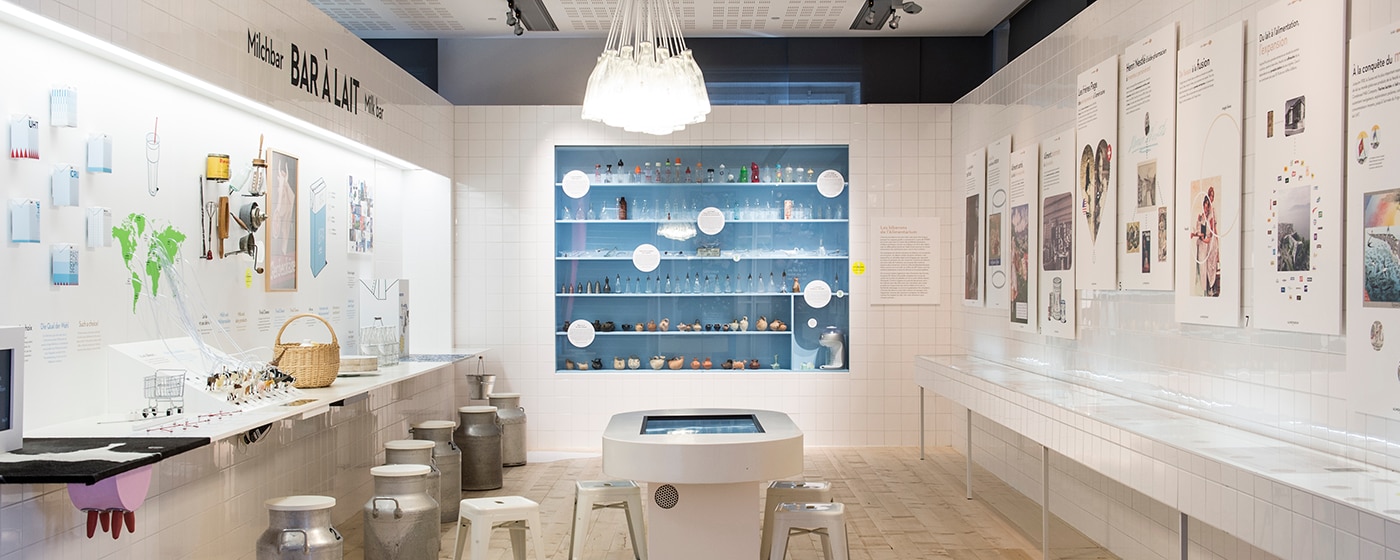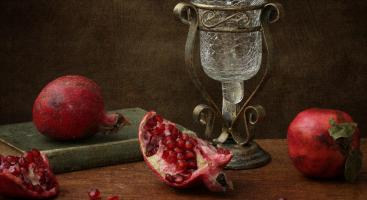The history of baby bottles
Presented in one single display cabinet that stretches along an entire section of wall in the Espace Lait area at the Alimentarium until August 2015, a multitude of feeding bottles collected by Professor Rossi (1915–1998) take you on a journey through history, from ancient times to modern day, to discover how newborns have been fed during the first few months of their lives.
A number of figurines depicting a mother and her child but, above all, a whole set of babies’ feeding bottles, make up the centre pieces of this collection of artefacts from ancient times until the end of the 1960s. Upon the death of her husband in 1998, Valéria Rossi was aware of the scientific interest in the items and donated her spouse’s collection to the Alimentarium to complete its first series of feeding bottles from the nineteenth and twentieth centuries.
Director of the University Hospital for Children in Berne from 1957 to 1985, Ettore Rossi had a significant influence on Swiss paediatrics. Passionate about history, this professor from the canton of Ticino collated a great deal of information on child care and feeding practices from ancient times through to the present day. These feeding bottles are not just beautiful and unusual artefacts but offer insight into the status of infants and how they have been fed over the centuries.
Maternal breastfeeding and substitutes
Evidence of using wet nurses dates back to the 18th century B.C. in Babylon. It was a practice that became the norm among the wealthy classes in Ancient Egypt, Greece and Rome. Soranos of Ephesus, a Greek doctor from the 2nd century A.D., described the ideal wet nurse: "She is between 20 and 40 years of age, honest, even-tempered, pleasant, in good health, has a good complexion, is of average size; her child is less than two months old, she is clean and her milk is neither too clear nor too thick."(1) A wet nurse was carefully chosen because it was thought that she would pass her qualities, or her vices, onto the child through her milk. Whether its origins were for cultural, moral or medical reasons, this trend was initially restricted to urban areas but was to filter into all levels of society between the 10th and 16th centuries. At the start of the modern era, the whole of Europe went on to adopt this practice: known as nourrices in France, they were called bala in Italy and nodriza or ama in Portugal. There was even talk of a real ‘wet nurse industry’ in the 19th century(2).
There is also evidence that feeding bottles were used during ancient times. An Egyptian papyrus dating from the 15th century B.C. includes a recommendation to use a drink made with "cow's milk and boiled wheat kernels", undoubtedly in the event that maternal milk was lacking(3). Soranos provided a lot of information on methods for feeding newborns during the Roman era. The colostrum was considered toxic to infants due to its thick consistency and the fact that it was difficult to digest. He advised introducing semi-solid food, such as breadcrumbs soaked in milk, mead, sweet wine or wine sweetened with honey, into the diet from the age of six months, at the onset of teething and to later introduce "gruel, very runny purée and a soft-boiled egg"(4). Texts written by Avicenna, a Persian doctor and philosopher, provide us with information about the practices in the Middle Ages: he recommended breastfeeding infants for two years and then gradually weaning until the child was able to eat all kinds of food. Infants were often fed animal milk, from cows or goats, as well as clear porridge made from milk and flour, served in horns or receptacles with cloth teats(5).
To address the lack of wet nurses who were highly sought-after between the 18th and 19th centuries, artificial feeding then became extremely popular. Wet nurses often looked after a number of children, raised "on small pots of food, porridge or the family's indigestible soup"(6). From the mid-19th century, breastfeeding substitutes based on animal milk — donkey, sheep, goat or cow — became increasingly popular in order to combat infant mortality. The discoveries of Pasteur and the subsequent techniques for sterilising feeding bottles significantly improved the sanitary risks associated with artificial feeding. The use of feeding bottles became widespread and they were initially made from pewter, tin plate, earthenware and porcelain, with glass bottles gradually becoming popular at the start of the 20th century.
Prehistoric times
Although none of the artefacts tell us about feeding infants during prehistoric times, a most recent study featured in Nature magazine offers some interesting insights. The levels of barium analysed in a child's molar from the Neanderthal period suggest that babies were breastfed for seven months, after which feeding was supplemented with other kinds of food for a further seven months, before the child was completely weaned at around 18 months(7). These results surprised the scientific community, as it is known that, in the natural world, female chimpanzees breastfeed their young for more than five years and that, according to parallel ethnographics, the age of weaning in non-industrialised populations is at around two and a half years of age. However, since this study is based upon the analysis of a single fossil tooth, it is not possible to generalise.
Ancient times
Antique feeding bottles, whether Etruscan, Hellenistic or Roman, retained a certain uniformity in terms of shape over a long period of time spanning thirteen centuries, from the 9th century B.C. to the 4th century A.D. Resembling small beakers with a handle, small enough to be held in the palm of the hand, they were a controversial subject for a long time. They were sometimes considered as feeding bottles but more frequently thought to be recipients used to fill up oil lamps, while glass bottles were thought to be vials for perfume. However, the results of analyses conducted during the 1990s on terracotta and glass feeding bottles confirmed the presence of saturated fatty acids that are only found in human or animal milk (stearic, capric, lauric and miristic acids), proving that these objects did in fact once contain milk(8). An experiment conducted by a young mother also demonstrated that, due to the shape and the presence of an opening on the top of the ceramic recipients, they may also have been used as a form of breast pump(9).
The terracotta bottles fitted with a pouring spout and a handle on the side are similar to miniature versions of cooking recipients, jugs or goblets. The askoï receptacles feature an off-centre opening and a handle on the top, while filter feeding bottles have a lid pierced with small holes. Small in size and with a low holding capacity, they can be held in the palm of the hand and hold one to two decilitres of liquid. The glass gutti bottles emerged during the 1st century A.D. and feature a very fine spout that was used to pour out the milk drop by drop. Often discovered in the tombs of very young buried children, they demonstrate that particular attention was paid to the young deceased. The inscriptions on gravestones reveal the affection that parents during Roman times bestowed upon their children: They mention being "deeply saddened" by their death or talk about "their dear child"(10).
Modern era: The appearance of the feeding bottle
A turning point came in the 16th century, when feeding bottles actually began to be shaped like a bottle, thus replacing the cow horns and terracotta jugs and goblets that had been used since ancient times. The high mortality rate of abandoned children or children left in hospices or with wet nurses, combined with the obsessive fear of depopulation, encouraged doctors to develop artificial feeding techniques based on animal milk. Made from a wide variety of materials, feeding bottles had certain common characteristics: whether made from wood, pewter or glass, the receptacles were tall, looked like bottles and featured a low-flow pierced tip, shaped like a nipple. A piece of fabric or a small sponge was often placed on the tip to prevent the child from hurting its gums during feeding. Solid bottles made from pewter, despite the high rate of mortality that they caused, were commonly used until the 19th century: the milk "by acidifying, ended up attacking and absorbing the metal, thus becoming a serious cause of intoxication for the child"(11).
From the 18th century, manufacturers tried to improve the comfort of newborns during feeding by making it easier to clean the receptacles. The ‘flat-shaped’ feeding bottle was then developed, followed by the Anglo-Saxon ‘banana’ made from blown glass. Its elongated shape allowed the baby to remain in an inclined position while its mother controlled the flow of the milk by pressing her thumb over one of the holes. The "clog" bottle featured a raised neck. Some feeding bottles were adorned with magnificent engraved floral designs, evidence of the luxury and wealth of rich European families.
Industrial progress to the benefit of consumer society
Between 1850 and 1950, the feeding bottle gave into the demands of modern society, which called for products that were tough, practical and inexpensive. Invented in 1860, the long-tube feeding bottle responded to this demand: the glass flask equipped with a rubber tube allowed the infant to more or less feed itself! Although initially acclaimed for its practical nature, this ‘killer tube’ was banned in 1910 as it proved a real breeding ground for bacteria. With the arrival of moulded glass, in particular heat-resistant Pyrex® in 1924, came straight feeding bottles, which were graduated and fitted with rubber teats. The neck of the bottle gradually became wider making sure it could be perfectly cleaned. In parallel, the development of new medical disciplines such as paediatrics and childcare contributed towards the diversification of food for newborns and young children. It was in this context that infant cereal and the first powdered milk were invented and developed in Switzerland by Henri Nestlé and Maurice Guigoz.
Post-war merchandising
After the Second World War, new materials such as bakelite appeared. The French manufacturer Remond used this Belgian invention from 1946 to create rings, with a view to fitting the teat on the neck of the bottle without actually touching the teat. From the 1960s, the ring, the body of the feeding bottle and the teat protector began to be manufactured out of polypropylene. The designs were now more fun, thanks to images of popular cartoon characters or brand logos that were printed on the bottles using silkscreen printing.
The 21st century, bottle-feeding resembles breastfeeding more than ever
From the 1990s onwards, feeding bottles have given both mother and baby an experience similar to that of maternal breastfeeding. Plastic and silicone feeding bottles are now virtually unbreakable, yet very smooth to touch. Designed for comfort and to minimize fatigue, some are shaped like an S or have play handles to help develop a baby’s psychomotricity. Teats have been adapted to babies’ needs: they are now made of silicone, are anti-colic and available with different flow rates and even "imitate the texture of skin". Progress has also been made on the health front, with the invention of the hygienic removable base and baby bottles made without bisphenol A, a synthetic compound presumed to be toxic. The summit of this evolution has to be the machine which now prepares baby feeding bottles using milk capsules, in response to the needs of our modern society.
D’après un texte de Cécile Lacharme publié dans La collection de biberons du Professeur Ettore Rossi. Pour une histoire de l’alimentation de l’enfant de l’Antiquité à nos jours, Alimentarium, 2004 et le catalogue d’exposition DEXTOX. Croyances autour de la nutrition, Alimentarium, 2014, enrichis et adaptés par Annabelle Peringer.









